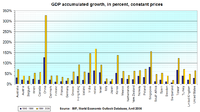
Photo from wikipedia
Studies of internal structure of gas giant planets suggest that their envelopes are enriched with heavier elements than hydrogen and helium relative to their central stars. Such enrichment likely occurred… Click to show full abstract
Studies of internal structure of gas giant planets suggest that their envelopes are enriched with heavier elements than hydrogen and helium relative to their central stars. Such enrichment likely occurred by solid accretion during late formation stages of gas giant planets in which gas accretion dominates protoplanetary growth. Some previous studies performed orbital integration of planetesimals around a growing protoplanet with the assumption of an uniform circumstellar disc to investigate how efficiently the protoplanet captures planetesimals. However, not only planetesimals but also disc gas are gravitationally perturbed by the protoplanet in its late formation stages, resulting in gap opening in the circumstellar disc. In this study, we investigate the effects of such gap formation on the capture of planetesimals by performing dynamical simulations of planetesimals around a growing proto-gas giant planet. Gap formation reduces the surface density of disc gas, makes a steep pressure gradient and limits the growth rate of the protoplanet. We find that the first effect enhances the capture of planetesimals, while the others reduce it. Consequently the amount of planetesimals captured during the gas accretion is estimated to be at most ~3 Mearth. We conclude that the in-situ capture of planetesimals needs the initial solid surface density more than five times higher than that of the minimum mass solar nebula for explaining the inferred large amount of heavy element in Jupiter. For highly dense warm Jupiters, we would need additional processes enhancing the capture and/or supply of planetesimals.
Journal Title: Monthly Notices of the Royal Astronomical Society
Year Published: 2019
Link to full text (if available)
Share on Social Media: Sign Up to like & get
recommendations!